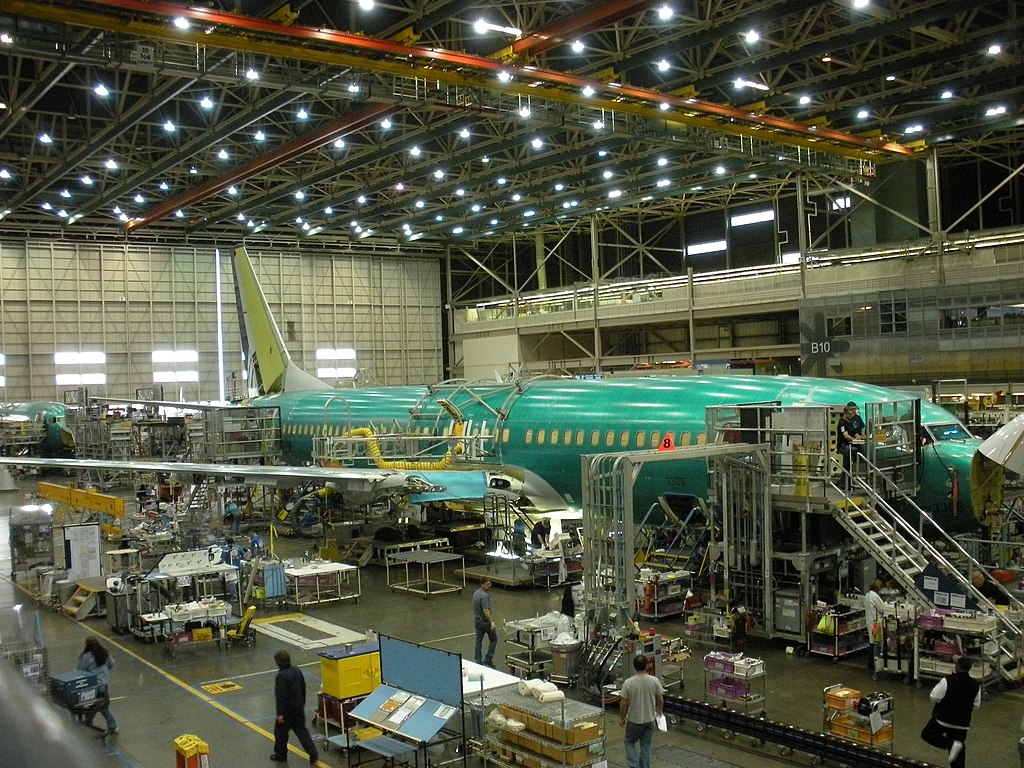
The Boeing 737 MAX program took another hit on January 5 when a 737 MAX 9 suffered a rapid depressurization incident during a flight from Portland, Oregon to Ontario, California.
Soon after takeoff at 5:06 p.m. local time, a “door plug” filling an unused mid-cabin emergency exit blew out as the aircraft’s hull pressurized while climbing out to altitude. The loss of the plug left a door-sized hole in the aircraft at 16,300 feet. The plane was able to quickly return to the airport and land safely, with only minor injuries reported to some of the 171 passengers and six crew members aboard.
Alaska Airlines immediately grounded its 737 Max 9 fleet as a precaution, and the Federal Aviation Administration (FAA) temporarily grounded all 171 737 Max 9s operated by US carriers for inspection, which include both Alaska Air and United Airlines.
The NTSB is investigating the cause of the incident, which obviously will take some time. It has recovered the blown-out panel but not the bolts that held it in place. Boeing has issued instructions for inspections of the door plug, and the FAA has issued an Emergency Airworthiness Directive (EAD) that requires operators to inspect affected aircraft before further flight. The FAA estimates that inspections will take around four to eight hours per aircraft. Now it’s a question of waiting to see what the inspections turn up and what kind of remedial action Boeing will take to address any risks associated with other aircraft.
The issue is unlikely to be a flaw in the design of the door plug since the same design has been used in Boeing’s 737-900 series and freighter conversions for years without incident. The aircraft involved, MSN 67501, is less than three months old – delivered in October 2023- so airframe fatigue is unlikely to have been involved.
The more likely cause is a breakdown in Boeing’s production line quality assurance process. The door plug failure came soon after Boeing told airlines to inspect part of the 737 MAX fleet for potentially loose bolts in the aircraft’s rudder control system. Before that, Boeing had to deal with improperly drilled holes in the aft bulkhead of a number of recently delivered MAX airliners, a problem that required substantial rework by Boeing and fuselage supplier Spirit AeroSystems.
How does this affect the 737 MAX production forecast for 2024 and beyond?
Assuming for the moment that the issue here was a lapse in quality control rather than a design flaw in the door plug, Boeing’s planned ramp-up of production in 2024-2026 will be able to continue largely unchanged. The inspections take only 4-8 hours because the door plug is relatively accessible to maintainers, and corrective action may involve only tightening loose bolts to spec. Aircraft could continue to roll off the line without requiring major rework. The entire incident will likely be forgotten by the flying public before too long.
So far I don’t see a reason to change the forecast for the 737 MAX. However, there are bigger issues here that pose risks for the MAX production outlook. Airlines understand that every aircraft program has its hiccups and technical issues that crop up in service, but if airlines begin to view the 737 as more prone to production snafus that endanger the safety of their aircraft and lead to repeated groundings, customers have a perfectly adequate substitute over at Airbus.
Even dedicated Boeing customers could begin to see a need to diversify their narrowbody fleets, which is usually a higher-cost option but may be worthwhile if they fear ongoing fleet-wide groundings while operating the MAX. That could lead to a further loss of market share to Airbus, which is gradually taking leadership in the segment due to the popularity of its stretched 180 to 220-passenger A321neo model.
Update – The FAA released a new statement on the process of returning grounded MAX 9 aircraft to flight status on January 9:
“Every Boeing 737-9 Max with a plug door will remain grounded until the FAA finds each can safely return to operation. To begin this process, Boeing must provide instructions to operators for inspections and maintenance. Boeing offered an initial version of instructions yesterday which they are now revising because of feedback received in response. Upon receiving the revised version of instructions from Boeing the FAA will conduct a thorough review. The safety of the flying public, not speed, will determine the timeline for returning the Boeing 737-9 Max to service.”
January 11 – In a new statement, the FAA adopted stronger language as it opened an investigation into the incident:
“This incident should have never happened and it cannot happen again. FAA formally notified Boeing that it is conducting an investigation to determine if Boeing failed to ensure completed products conformed to its approved design and were in a condition for safe operation in compliance with FAA regulations. This investigation is a result of an incident on a Boeing Model 737-9 MAX where it lost a “plug” type passenger door and additional discrepancies. Boeing’s manufacturing practices need to comply with the high safety standards they’re legally accountable to meet. The letter is attached.”
The letter notifies Boeing of a new investigation into quality control on the MAX production line because the manufacturer, “may have failed to ensure its completed products conformed to its approved design and were in a condition for safe operation in accordance with quality system inspection and test procedures.”
A wider investigation into the MAX production line could impact the forecast for 2024 and 2025. Boeing needs to do more than assure regulators that it is tackling the issues that led to the failure of the door plug and other production line issues it has suffered recently. That may require further training, more inspectors, and other steps that could slow the manufacturer’s planned production ramp up.
A lifelong aviation enthusiast, Douglas Royce is currently co-editor of four of Forecast International's Market Intelligence Services: Civil Aircraft Forecast, Military Aircraft Forecast, Rotorcraft Forecast, and Aviation Gas Turbine Forecast. As such, he plays a key role in many important projects that involve market sizing and forecasting for various segments of the world aerospace industry, as well as demand for related systems.




